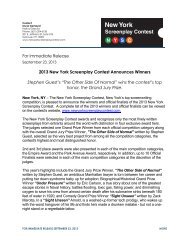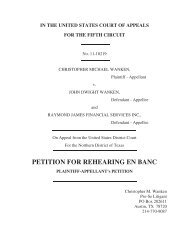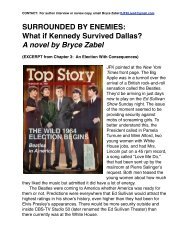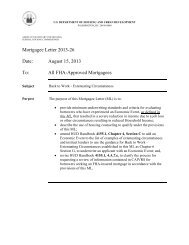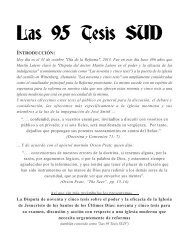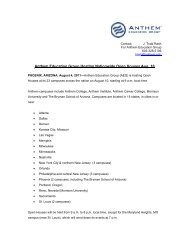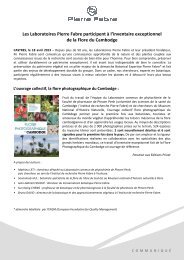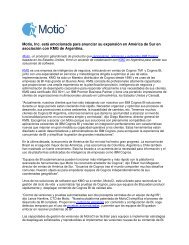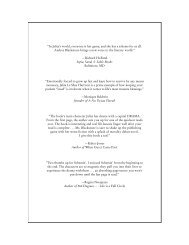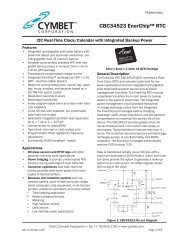The Connector Website Model New Implications for Social ... - PRWeb
The Connector Website Model New Implications for Social ... - PRWeb
The Connector Website Model New Implications for Social ... - PRWeb
Create successful ePaper yourself
Turn your PDF publications into a flip-book with our unique Google optimized e-Paper software.
2006, pp. 47-53. Forbes.com has an excellent visual presentation summarizing representative<br />
websites based on niche, embedded in Rachel Rosmarin, “<strong>The</strong> MySpace Bubble,” Forbes.com,<br />
June 29, 2006: http://www.<strong>for</strong>bes.com/home/digitalentertainment/2006/06/29/myspace-networkfacebook_cx_rr_0629socialnetwork.html<br />
7 Howard Rheingold, <strong>The</strong> Virtual Community: Homesteading on the Electronic Frontier,<br />
(Reading, MA: Addison-Wesley, 1993); Laura Garton, Caroline Haythornwaite, and Barry<br />
Wellman, “Studying Online <strong>Social</strong> Networks,” Journal of Computer Mediated Communications,<br />
Vol. 3, No. 1, (June 1997); Peter Kollock, “Design Principles <strong>for</strong> Online Communities,” PC<br />
Update, Vol. 15, No. 5 (June 1998), pp. 58-60; Peter Kollock and Marc A. Smith, “Communities<br />
in Cyberspace,” in Communities in Cyberspace, Peter Kollock and Marc A. Smith, eds., (<strong>New</strong><br />
York: Routledge, 1999), pp. 3-28; Barry Wellman and Milena Gulia, “Net Surfers Don’t Ride<br />
Alone: Virtual Communities as Communities,” in Communities in Cyberspace, Peter Kollock and<br />
Marc A. Smith, eds., (<strong>New</strong> York: Routledge, 1999), pp. 167-194; Barry Wellman and Keith<br />
Hampton, “Living Networked On and Offline,” Contemporary Sociology, Vol. 28, No. 6<br />
(November 1999), pp. 648-654; Jenny Preece, Online Communities: Designing Usability and<br />
Supporting Sociability, (<strong>New</strong> York: John Wiley & Sons, Inc., 2000); Robert McArthur and Peter<br />
Bruza, “<strong>The</strong> ABCs of Online Community,” Lecture Notes in Computer Science, Vol. 2198<br />
(2001), pp. 141-147; Lada A. Adamic, Orkut Buyukkokten, and Eytan Adar, “A <strong>Social</strong> Network<br />
Caught in the Web,” First Monday, Vol. 8, No. 6 (June 2003); Devan Rosen, Joseph Woelfel,<br />
Dean Krikorian, and George A Barnett, “Procedures <strong>for</strong> Analyses of Online Communities,”<br />
Journal of Computer-Meidated Communication, Vol. 8, No. 4 (July 2003); Jenny Preece, and<br />
Diane Maloney-Krichmar, “Online Communities: Design, <strong>The</strong>ory, and Practice,” Journal of<br />
Computer-Mediated Communication, Vol. 10, No. 4 (July 2005), article 1; Andrea Kavanaugh,<br />
John M. Carroll, Mary Beth Rosson, Than Than Zin, and Debbie Denise Reese, “Community<br />
Networks: Where Offline Communities Meet Online,” Journal of Computer-Mediated<br />
Communication, Vol. 10, No. 4 (July 2005), article 3. Also see recent work conducted by the<br />
Community Lab, a collaborative project of the University of Minnesota, University of Michigan,<br />
and Carnegie Mellon University: http://www.communitylab.org.<br />
8 John Horrigan, Online Communities: Networks That Nurture Long Distance Relationships and<br />
Local Ties, (Pew Internet & American Life Project, 2001); Pew Internet & American Life<br />
Project, Internet: <strong>The</strong> Mainstreaming of Online Life: Trends 2005, (Pew Internet & American<br />
Life Project, 2005); Center <strong>for</strong> the Digital Future, Highlights: Digital Future Project 2005, (Los<br />
Angeles: Center <strong>for</strong> the Digital Future, 2005). Also see the recent report by Jeffrey Boase, John<br />
B. Horrigan, Barry Wellman, and Lee Rainie, <strong>The</strong> Strength of Internet Ties, (Washington DC:<br />
Pew Internet & American Life Project, 2006).<br />
9<br />
See Ronald Coase, “<strong>The</strong> <strong>New</strong> Institutional Economics,” <strong>The</strong> American Economic Review, Vol.<br />
88, No. 2 (May 1998), pp. 72-74.<br />
10 <strong>The</strong>re are non-connector websites that build online communities. Examples are consumer<br />
websites such as Amazon.com and Edmunds.com; lifestyle websites such as iVillage and<br />
Askmen.com; music sharing websites like Napster or BearShare. Under close examination these<br />
sites do not meet the operational definition of the connector website found on pp. 5-6.<br />
This study was restricted to investigating websites that have major social search and/or social<br />
networking web applications. Further research needs to be done regarding three classes of<br />
websites with distinctly different applications: (1) wiki websites (e.g. Wikipedia); (2) fantasy<br />
sports websites (e.g. Yahoo! Fantasy Sports); and (3) gamer websites (e.g. World of Warcraft).<br />
34



